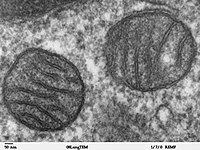
Photo from wikipedia
Barth syndrome (BTHS) is an X‐linked disorder that results from mutations in the TAFAZZIN gene, which encodes a phospholipid transacylase responsible for generating the mature form of cardiolipin in inner… Click to show full abstract
Barth syndrome (BTHS) is an X‐linked disorder that results from mutations in the TAFAZZIN gene, which encodes a phospholipid transacylase responsible for generating the mature form of cardiolipin in inner mitochondrial membranes. BTHS patients develop early onset cardiomyopathy and a derangement of intermediary metabolism consistent with mitochondrial disease, but the precise alterations in cardiac metabolism that distinguish BTHS from idiopathic forms of cardiomyopathy are unknown. We performed the first metabolic analysis of myocardial tissue from BTHS cardiomyopathy patients compared to age‐ and sex‐matched patients with idiopathic dilated cardiomyopathy (DCM) and nonfailing controls. Results corroborate previous evidence for deficiencies in cardiolipin content and its linoleoyl enrichment as defining features of BTHS cardiomyopathy, and reveal a dramatic accumulation of hydrolyzed (monolyso‐) cardiolipin molecular species. Respiratory chain protein deficiencies were observed in both BTHS and DCM, but a selective depletion of complex I was seen only in BTHS after controlling for an apparent loss of mitochondrial density in cardiomyopathic hearts. Distinct shifts in the expression of long‐chain fatty acid oxidation enzymes and the tissue acyl‐CoA profile of BTHS hearts suggest a specific block in mitochondrial fatty acid oxidation upstream of the conventional matrix beta‐oxidation cycle, which may be compensated for by a greater reliance upon peroxisomal fatty acid oxidation and the catabolism of ketones, amino acids, and pyruvate to meet cardiac energy demands. These results provide a comprehensive foundation for exploring novel therapeutic strategies that target the adaptive and maladaptive metabolic features of BTHS cardiomyopathy.
Journal Title: Journal of Inherited Metabolic Disease
Year Published: 2021
Link to full text (if available)
Share on Social Media: Sign Up to like & get
recommendations!